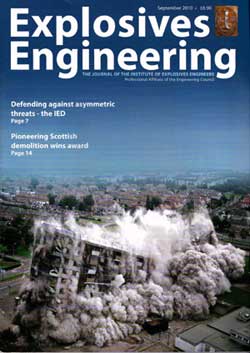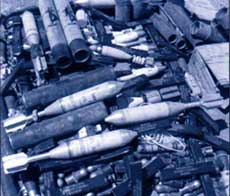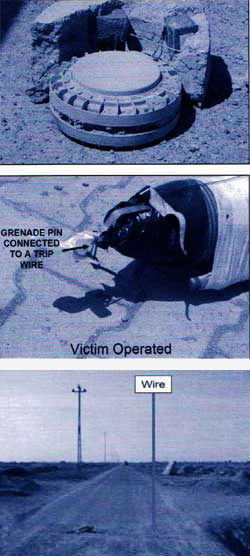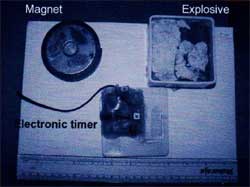
Defending Against Asymmetric Threats - The IED
By Lieutenant-General Jonathon Riley CB DSO PhD MA FRHistS
The Director-General & Master, The Royal Armouries, first gave this presentation to the IExpeE Annual Dinner, April 2010

There is not a day that goes by, or so it seems, that we do not hear of yet another of our best young men and women being killed or injured in Afghanistan by a roadside bomb - in military parlance an improvised explosive device or IED. But this phenomenon is not new: it was a feature of anarchist campaigns of the nineteenth century; the British Army faced it in Northern Ireland for over thirty years and it was a formidable problem in Iraq where Iranian support provided a very high level of technical capability. The Israelis too have had to deal with it when confronting Hizbollah - who are also of course Iranian backed. But it is the campaign in Afghanistan that has thrown the weapon into the public eye.

Theatres of war can provide a ready
source of material for the IED maker,
as this cache from Iraq in 2004 shows
The insurgency in Afghanistan began in 2006 by trying to confront NATO and US forces head-on, in large-scale engagements. The insurgents pressed these tactics throughout 2006 and 2007 and their losses were enormous. In the winter of 2007, therefore, the leaders of the various insurgent groups (for the Taliban is not monolithic) re-evaluated their tactics. From then on, the insurgency became characterised by a proliferation of small groups, generally with defined areas of operation and highly mobile. Rather than engage in symmetrical battles, the insurgency's military, administrative and information operations aimed to dominate provinces without actually occupying territory through a culture of fear generated by the impression that the Taliban could and would appear anywhere at any time. As much as anything, its fighters were increasingly unable and unwilling to do otherwise because of the impact of heavy casualties. In military operations against Allied forces, therefore, there was a shift throughout 2008 from a few large attacks to a much larger number of small and asymmetrical attacks using IEDs, indirect fire and complex ambush.
Taking 2008 as the year that saw the big change in Taliban methodology, by late October - the close of the Taliban's fighting season - Afghanistan had seen a 52% increase in ID attacks compared to the previous year, with 80% of Allied and Afghan security force casualties coming from IED's. That trend has continued and the figure is now above 90% of casualties being caused by these devices, which are often deployed in belts around security-force bases and on main routes. The suicide bomber is a specific sub-set of this threat, a low-tech precision guided munition if you will, but outside the scope of this article.
Historically this shift in tactics is not surprising. Adversaries will always pick alternative strategies reflecting those the weak have consistently adopted against the strong: concentrating on imposing pain rather than winning battles; gaining time rather than moving to closure; targeting the enemy's domestic political base as much as his forward military capabilities; relying on his intolerance of casualties and his weaker stake in the resolution of the conflict; and playing upon his reluctance to cause civilian suffering.
The issue of civilian casualties is certainly a major Strategic Communications challenge. In spite of what the media would have us believe, egged on by human rights activists and well-meaning but easily duped officials, there is no doubt that the vast majority of non-combatants are killed by the Taliban and other insurgent groups. The IED is by far the biggest killer of civilians, not NATO air strikes. IEDs are not therefore to be treated as just a temporary tactical problem.
The ID threat

Technical counter-measures can defeat some
means of remote controlled initiation, but tactical
counter-measures are still required to counter the
old standby of the trip -wire, or combination of
trip or remote control
The advantages of the IED to the insurgent are obvious: IEDS require relatively low technology, and are therefore cheap to make with a low training bill; they are easy to conceal and hard to detect, while being low risk to the attacker; many components are commercially available; and commercial explosive is relatively easy to acquire through quarries or construction companies; home-made explosive can be made from nitrate fertiliser and fuel oil. In Iraq and Afghanistan, thousands of tons of old munitions are freely available, the legacy of years of warfare and a highly militaries society.
Over time, too, we have seen a variety of methods on initiation:
- The simple long fuse, the clockwork and the electric timer
- the command wire
- the victim operated trigger - either trip wire, pressure pad, or infra-red beam
- remote initiation be it by radio or mobile phone or by wireless.
- There are also combinations of these which aim to put the initiator beyond the range of our weapons or are outside the umbrella of our technical counter-measures.
These methods are not strictly chronological. All are liable to counter-measures, either technical or tactical, or a combination of both, and there will thus develop a constant cycle of innovation and counter-measure - both up and down the ladder of technology. For example, effective counter-measures against remote control devices may either cause the bomber to go up to the infra-red initiation, for which there are expensive technical counter-measures; or he can go down to command wire against which there is no technical counter-measure but an increased risk of prior detection while digging in the wire. In this context we must understand too that many electronic counter-measures, which are simply broad-spectrum jammers, have as much of an effect on our own communications capabilities as they do on the devices.
In Iraq we have seen the combination of infra-red, victim-operated initiation with explosively-formed projectile technology supplied by the Iranians. Rather than just a huge explosion, this form of device fires a shaped charge at an extremely high velocity resulting in deep penetration. Its lethality is therefore extreme. EFP attacks against British troops in Southern Iraq had an average of 1.3 deaths per attack, plus injuries - whereas standard munitions or explosive-based IEDS had a lethality rate of less than 0.03 deaths per attack. Frequently there have been discoveries of multiple banks of these devices, indicating that supply is not a problem for the insurgent. We have yet to see this deployed in Afghanistan.
The next factor which has accelerated the threat, and the rate of innovation and counter-measure, is the internet. In effects-based warfare we must always be aware that there are two sorts of effects around; those we intend, and those we do not intend. This falls into the latter category. The internet and mobile phone technology allow the rapid transfer of know-how from one group to another, across continents and oceans. Do a trawl - you will be amazed at what is there. In the 1970s, it would routinely take six months to a year for techniques to pass from Hizbollah to the IRA and vice-versa. Today, that process takes a few hours.
The IED System

Simple timer initiators leave few traces that
can
be followed back to the initiators
From the above discussion, it seems obvious that we must view the IED as the product of a system, or network. This network has a number of components that make it up:
- The ideological leadership - providing motivation, finance, command
- Technical experts who develop and disseminate the technology, and review counter-measures
- A production team - to assemble components and cerate different devices
- A sub-network to transport components and complete devices
- A training organisation for bombers, movers, and protection teams
- An intelligence gathering and targeting organisation
- A protection/security team which as well as looking after the bombers and associates will also, as far as possible, remove evidence after the attack
- And finally, at the tip of the iceberg, the bomber who emplaces and activates the device.

Camoflage and anti-handling take many forms
Despite having featured in our lives for so long, I contend that we still do not counter this network with an effective, systemic approach of our own, even though enormous strides have been made. Certainly, we exploit forensics and technical intelligence, we develop counter-measures, we train troops, and we kill bombers. But we do not do so in a concerted way that seeks to break the cycle. We have not developed capability - which may be defined as the product of intelligence, equipment, trained personnel, doctrine and procedures, and sustainability. We do not do this nationally, never mind internationally, and given that the IED network respects no national boundaries, we have to do this on a coalition basis.
Dealing with the network
Such a systemic or networked attack on the IED bombers should be organised along four lines of operation (the ways), each designed to produce specific effects (the ends), and each employing specific means. We knew this in Northern Ireland, where we lived with the IED threat, developed intelligence at every level, and operated against the networks. In Iraq it seemed astonishing that with some degree of ease, the insurgency could inflict casualties on us, despite all that experience. However, the fact was that seven years of cease-fire in NI had bred a whole new generation that had not lived and breathed that experience. The Army had developed corporate amnesia, as organisations tend to do, and had to start all over again with the business of learning lessons the hard way.
Defeat the ID system
We have to understand that we are dealing with a system, and break that system. This means that internationally, there must be no sanctuary for those who develop, train, transmit or take part in IED technology and attacks. We have to harness a variety of means, such as: the forensic exploitation of devices. We actually have a very good apparatus for doing this, the Combined Exploitation Cell. We need to intercept and exploit the virtual realm. Operational/strategic Intelligence, Surveillance and Reconnaissance including signals, electronic, satellite and human intelligence has to be resourced and developed across various agencies. We need to be robust in exploiting intelligence from detainees and we need intelligence and technology exchanges with allies, clients, coalition and regional partners. Finally, we must develop pro-active media and information campaigns.
Of course we require the right legal framework to be established for the prosecution of offensive operations against the network, in past insurgencies, including Northern Ireland, the law was changed in order to give us the initiative. We need to follow that logic here, despite the pressure from the human rights lobby, or we will lose the battle.

As communications and information technologies increase, so too do the opportunities of the IED maker.
Defeat the ID Device
Of course we need to defeat the device, so that our own forces are able to operate with freedom of movement, fully prepared for the threat, able to dislocate, disrupt or defeat attacks; and that civilians are able to go about their normal business. This is a technical and a tactical response. Again we need to develop a variety of means including the technical exploitation of recovered devices, detainee exploitation, tactical human intelligence from the local population. We also need constantly to develop our analysis and prediction capability, along with the capability to carry our covert surveillance of suspects. likely ambush sites, caches and so on. If we are not to fall once more into the trap of losing our collective experience, we musts have a strong lessons-learned process in operation which identifies lessons and then teaches them through the forces in order to produce changes in doctrine, practice and equipments; tactics, techniques and procedures resulting from lessons learned have to be established as part of generic and special to theatre training - but this at least is getting well established.
This will be very much the bread and butter of the tactical land force or police commander in the theatre of operations and it requires heavy security force densities to cover the ground twenty-four hours a day, to maintain observation and strike capabilities and to deny the insurgent freedom of action. The biggest reason for the success of the IED campaign in Afghanistan is down to this: an under-resourced military force that does not have the numbers that we know from historical norms to be required.
Enable partners
Since we are never likely to be able to generate enough forces ourselves, and because long-term ownership of the problem lies with indigenous forces, we need to enable our partners in order to establish a non-permissive environment throughout a theatre; clients, allies and civil agency partners must be able to operate effectively and this means loosening some of the restrictions currently in place to enable exchanges of technology and intelligence, joint/combined .interagency training, the right legal framework for the prosecution of operations, and that pro-active media/info campaign that places awareness of the threat in the public consciousness and responsibility for death and injury where it belongs.
Deconfliction
This is a technical issue and one with heavy classification issues, but an important one if we want our own forces, clients, allies and civil agency partners to be able to operate effectively. Suffice to say here that we have to be serious about management of the electro-magnetic spectrum and not leave it to technicians alone; we need commonly agreed tactics, techniques and procedures for equipment deployment and employment; and we require technical exploitation and innovation mechanisms based on the exchange of intelligence.
Command and control
Of course, if this is to work it must have someone in charge: one person or group of people filling the converse role of the enemy's ideological leadership - providing motivation, finance and resources, command, a legal framework. It must have the right authorities. In turn the commander must delegate resources and authority to subordinates while exercising his responsibilities for overall direction of the campaign. As in so many other areas, flexibility will be the key to fighting an agile and responsive enemy. failure to delegate, therefore, will be the same as failure to resource.
So the next time you hear military commanders or even politicians blamed for deaths or injury by IEDs because the "right vehicles" were not available, please get under the hysteria and remember there is more to it than simple force protection. I have seen an IED put a main battle tank on its back. There is no silver bullet here, despite what some defence industrial companies would have us believe. The IED is part of a network, a system, and if we are to beat it, our system must be stronger.
Article Copyright © 2010 Jonathon Riley
More articles like this...
The Nexus: War, Insurgency and Criminality » NATO Summit »Private Sector Operations »
Copyright Notice: Unless explicitly stated otherwise, all rights including those in copyright of the documents and content of this website are owned by or controlled for these purposes by Jonathon Riley (Generalship Ltd). Except as otherwise expressly permitted under copyright law or Generalship Ltd's Terms of Use, the aforementioned content may not be copied, reproduced, republished, downloaded, posted, broadcast or transmitted in any way without first obtaining written permission of the copyright owner.